Abstract
Although gamma delta T cells are found in increased numbers in the spleens of humans and mice infected with malaria, it is not known if these cells are necessary components of an effective immune response. The surface phenotype of spleen cells obtained from mice infected with avirulent Plasmodium chabaudi adami or virulent Plasmodium chabaudi chabaudi were examined using anti-delta or anti-alpha beta T-cell-specific reagents and flow cytometry. Levels of parasitaemia, red blood cell (RBC) counts, and survival times were followed in mice depleted of tumour necrosis factor (TCR)gamma delta+ or TCR alpha beta+ T cells. Numbers of gamma delta T cells increased in the spleens of control antibody-treated infected mice, but not in mice depleted of TCR gamma delta+ or TCR alpha beta+ T cells. Mice depleted of gamma delta T cells had levels of parasitaemia, RBCs, and survival rates similar to control antibody-treated mice. However, mice depleted of TCR alpha beta+ T cells had higher levels of parasitaemia, lower RBC counts, and decreased survival rates. These results indicate that TCR alpha beta+ but not TCR gamma delta+ T cells play an essential role in host defense against P. chabaudi infection in mice.
Full text
PDF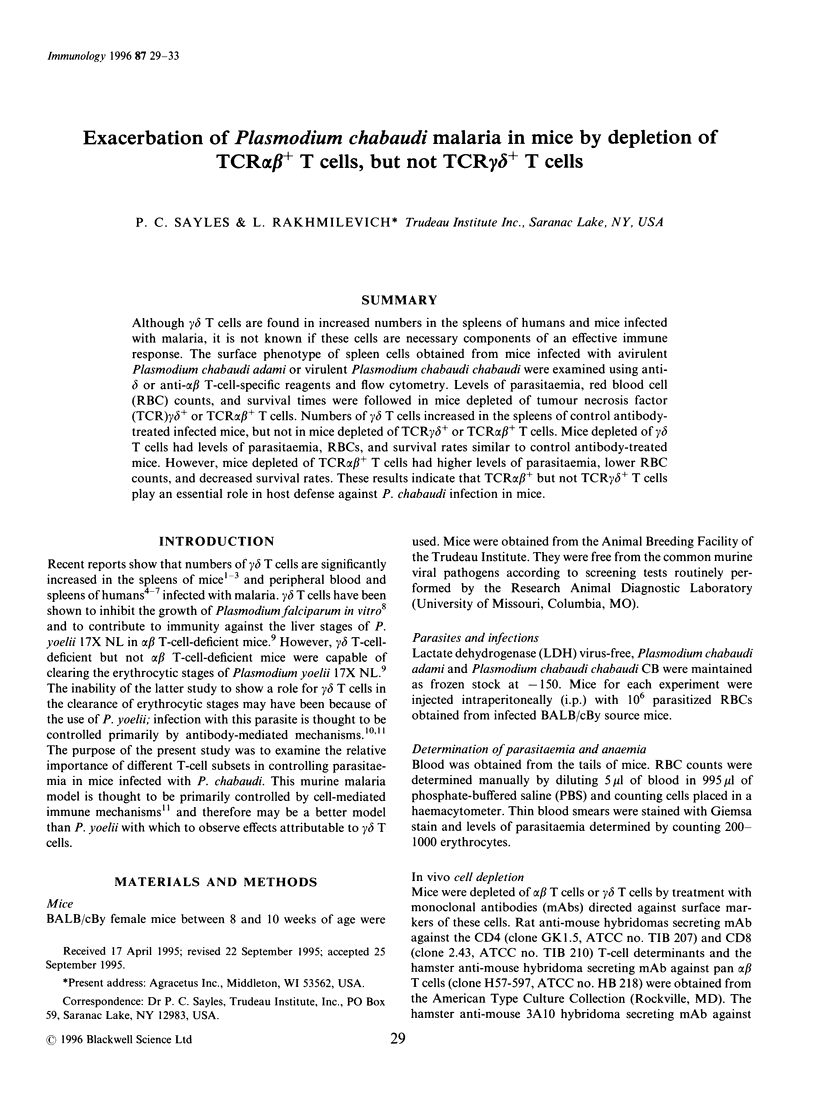
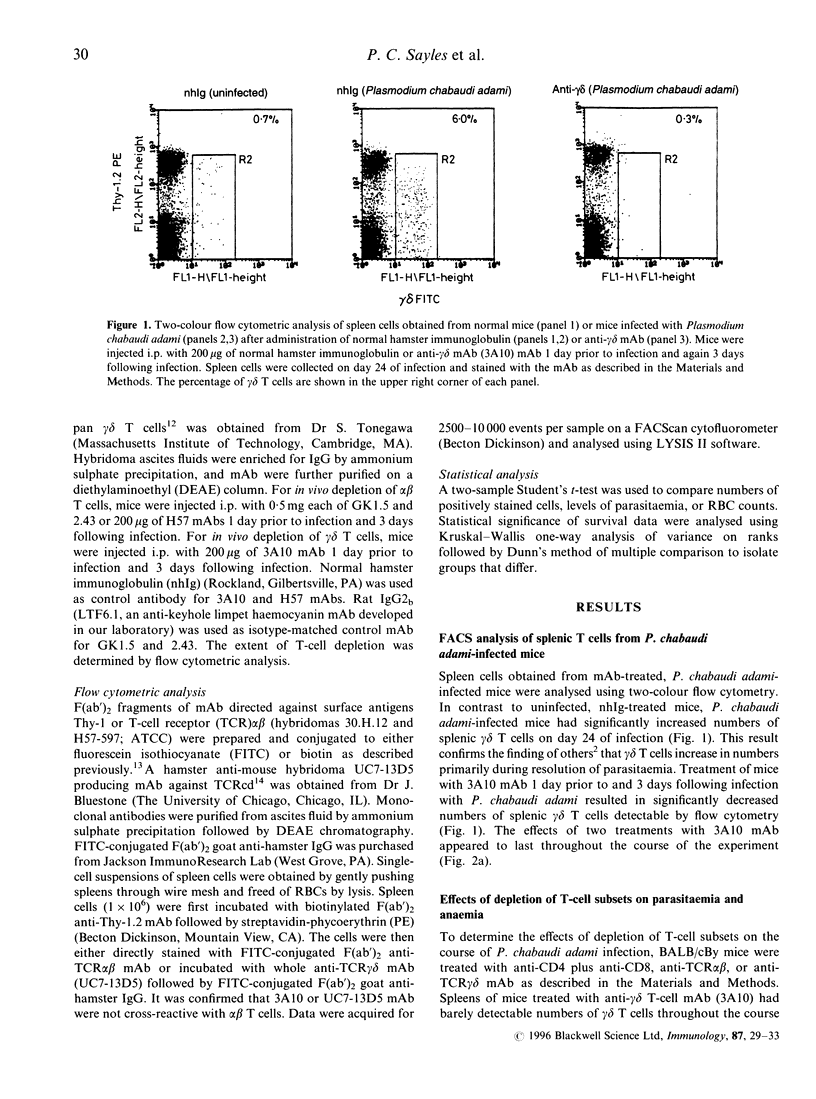
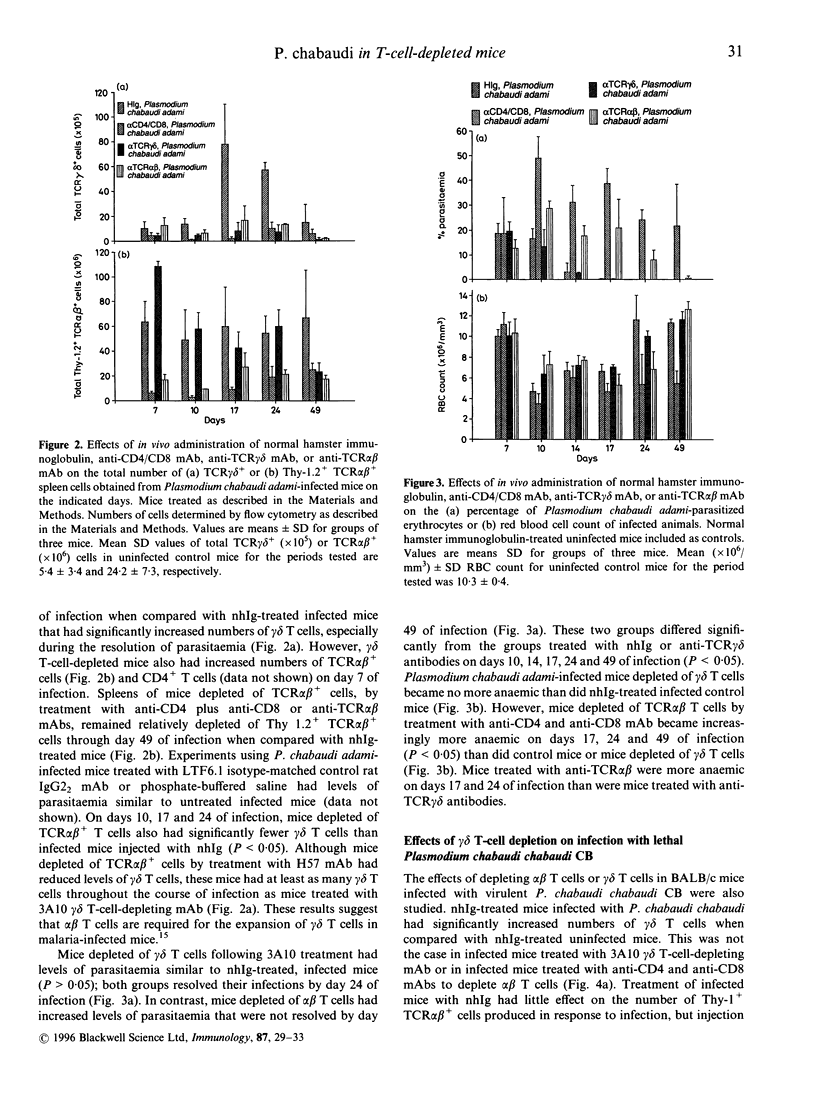
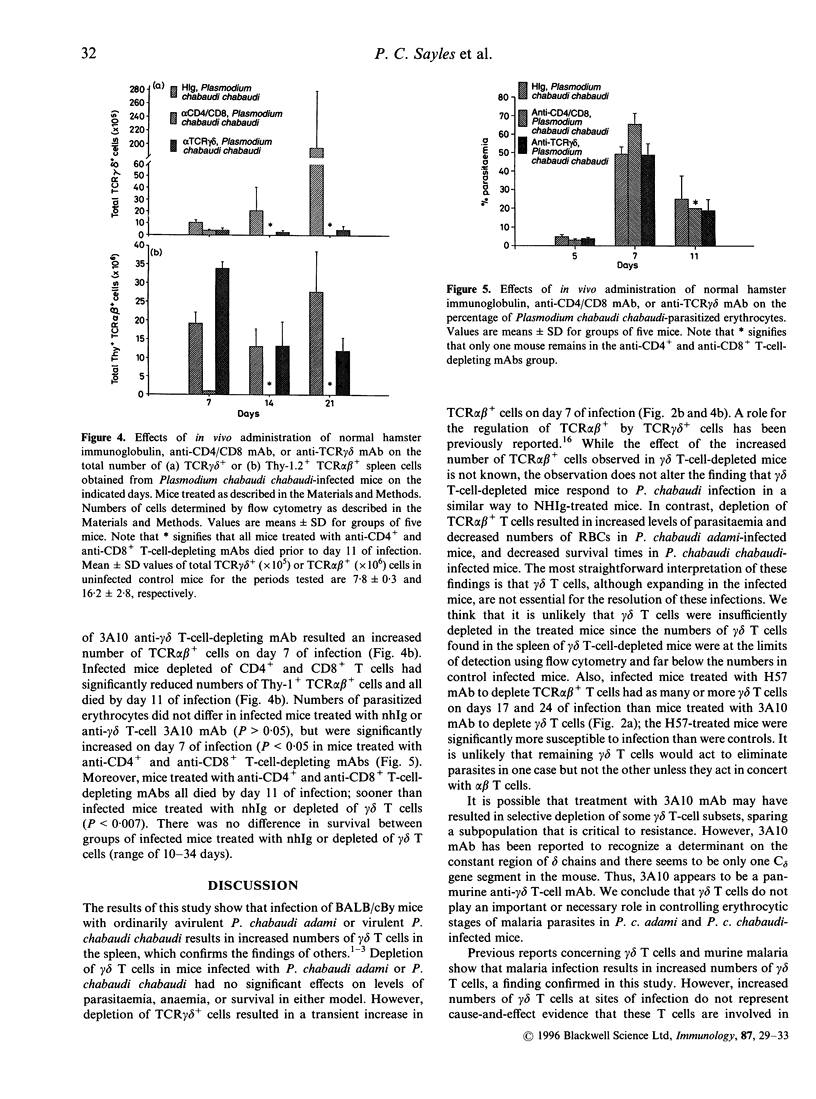
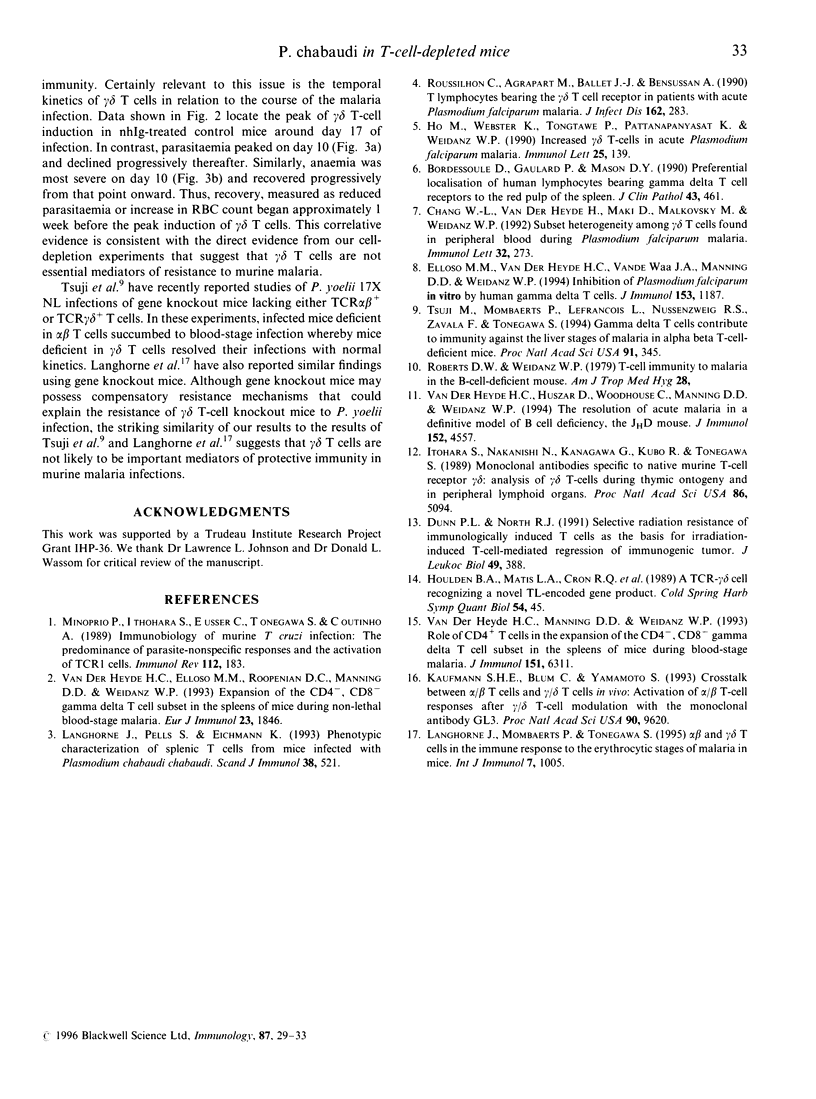
Selected References
These references are in PubMed. This may not be the complete list of references from this article.
- Bordessoule D., Gaulard P., Mason D. Y. Preferential localisation of human lymphocytes bearing gamma delta T cell receptors to the red pulp of the spleen. J Clin Pathol. 1990 Jun;43(6):461–464. doi: 10.1136/jcp.43.6.461. [DOI] [PMC free article] [PubMed] [Google Scholar]
- Chang W. L., van der Heyde H., Maki D. G., Malkovsky M., Weidanz W. P. Subset heterogeneity among gamma delta T cells found in peripheral blood during Plasmodium falciparum malaria. Immunol Lett. 1992 May;32(3):273–274. doi: 10.1016/0165-2478(92)90061-r. [DOI] [PubMed] [Google Scholar]
- Dunn P. L., North R. J. Selective radiation resistance of immunologically induced T cells as the basis for irradiation-induced T-cell-mediated regression of immunogenic tumor. J Leukoc Biol. 1991 Apr;49(4):388–396. doi: 10.1002/jlb.49.4.388. [DOI] [PubMed] [Google Scholar]
- Elloso M. M., van der Heyde H. C., vande Waa J. A., Manning D. D., Weidanz W. P. Inhibition of Plasmodium falciparum in vitro by human gamma delta T cells. J Immunol. 1994 Aug 1;153(3):1187–1194. [PubMed] [Google Scholar]
- Ho M., Webster H. K., Tongtawe P., Pattanapanyasat K., Weidanz W. P. Increased gamma delta T cells in acute Plasmodium falciparum malaria. Immunol Lett. 1990 Aug;25(1-3):139–141. doi: 10.1016/0165-2478(90)90105-y. [DOI] [PubMed] [Google Scholar]
- Itohara S., Nakanishi N., Kanagawa O., Kubo R., Tonegawa S. Monoclonal antibodies specific to native murine T-cell receptor gamma delta: analysis of gamma delta T cells during thymic ontogeny and in peripheral lymphoid organs. Proc Natl Acad Sci U S A. 1989 Jul;86(13):5094–5098. doi: 10.1073/pnas.86.13.5094. [DOI] [PMC free article] [PubMed] [Google Scholar]
- Kaufmann S. H., Blum C., Yamamoto S. Crosstalk between alpha/beta T cells and gamma/delta T cells in vivo: activation of alpha/beta T-cell responses after gamma/delta T-cell modulation with the monoclonal antibody GL3. Proc Natl Acad Sci U S A. 1993 Oct 15;90(20):9620–9624. doi: 10.1073/pnas.90.20.9620. [DOI] [PMC free article] [PubMed] [Google Scholar]
- Langhorne J., Mombaerts P., Tonegawa S. alpha beta and gamma delta T cells in the immune response to the erythrocytic stages of malaria in mice. Int Immunol. 1995 Jun;7(6):1005–1011. doi: 10.1093/intimm/7.6.1005. [DOI] [PubMed] [Google Scholar]
- Langhorne J., Pells S., Eichmann K. Phenotypic characterization of splenic T cells from mice infected with Plasmodium chabaudi chabaudi. Scand J Immunol. 1993 Dec;38(6):521–528. doi: 10.1111/j.1365-3083.1993.tb03235.x. [DOI] [PubMed] [Google Scholar]
- Roussilhon C., Agrapart M., Ballet J. J., Bensussan A. T lymphocytes bearing the gamma delta T cell receptor in patients with acute Plasmodium falciparum malaria. J Infect Dis. 1990 Jul;162(1):283–285. doi: 10.1093/infdis/162.1.283-a. [DOI] [PubMed] [Google Scholar]
- Tsuji M., Mombaerts P., Lefrancois L., Nussenzweig R. S., Zavala F., Tonegawa S. Gamma delta T cells contribute to immunity against the liver stages of malaria in alpha beta T-cell-deficient mice. Proc Natl Acad Sci U S A. 1994 Jan 4;91(1):345–349. doi: 10.1073/pnas.91.1.345. [DOI] [PMC free article] [PubMed] [Google Scholar]
- van der Heyde H. C., Elloso M. M., Roopenian D. C., Manning D. D., Weidanz W. P. Expansion of the CD4-, CD8- gamma delta T cell subset in the spleens of mice during non-lethal blood-stage malaria. Eur J Immunol. 1993 Aug;23(8):1846–1850. doi: 10.1002/eji.1830230817. [DOI] [PubMed] [Google Scholar]
- van der Heyde H. C., Huszar D., Woodhouse C., Manning D. D., Weidanz W. P. The resolution of acute malaria in a definitive model of B cell deficiency, the JHD mouse. J Immunol. 1994 May 1;152(9):4557–4562. [PubMed] [Google Scholar]


